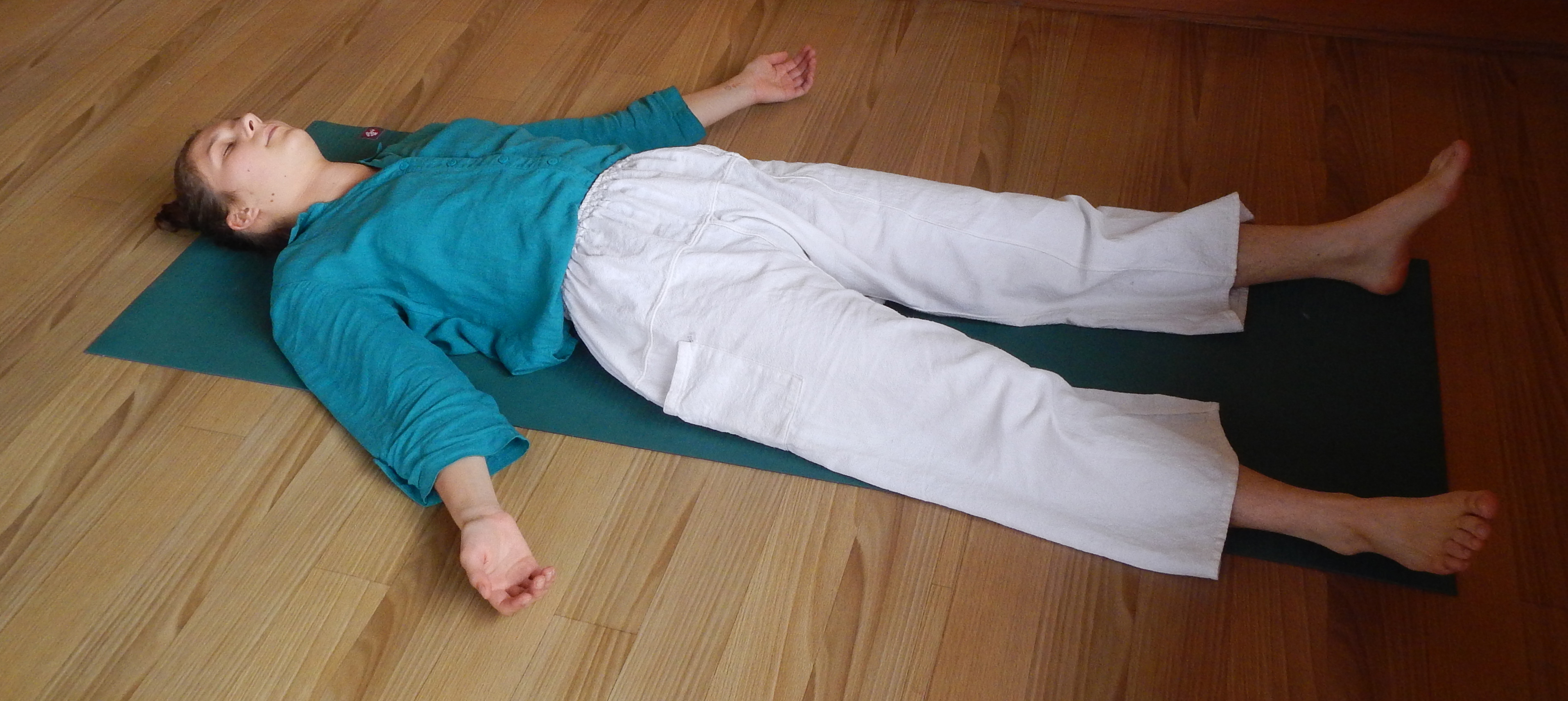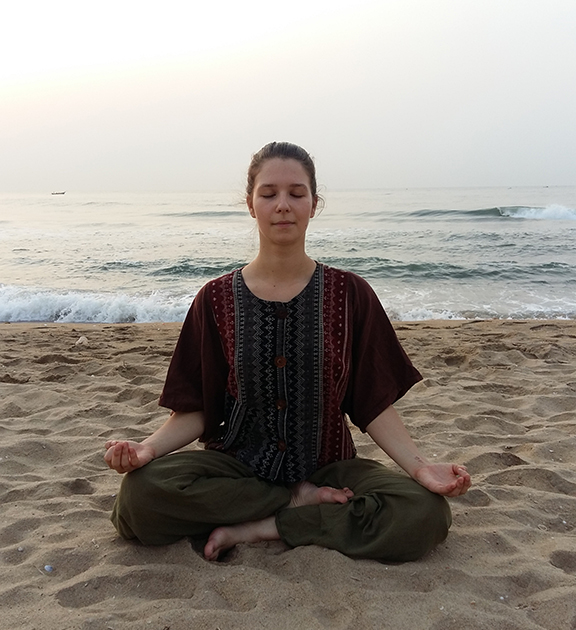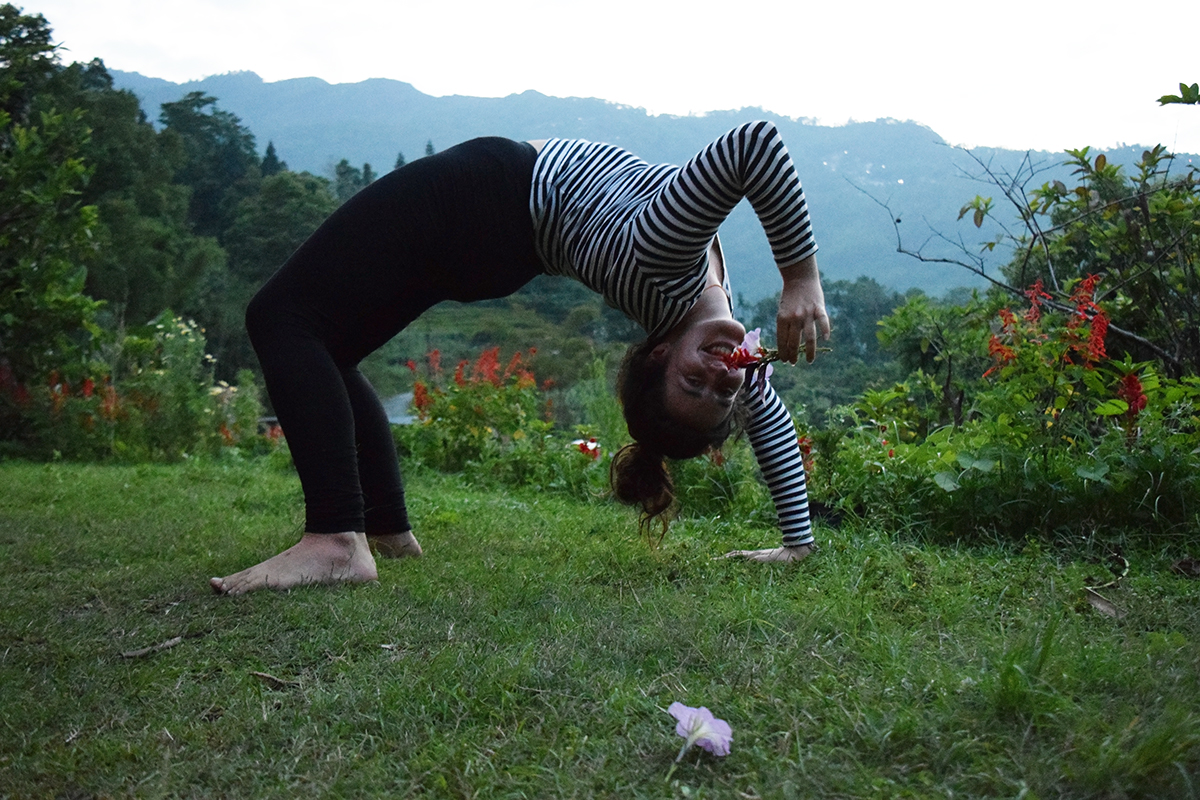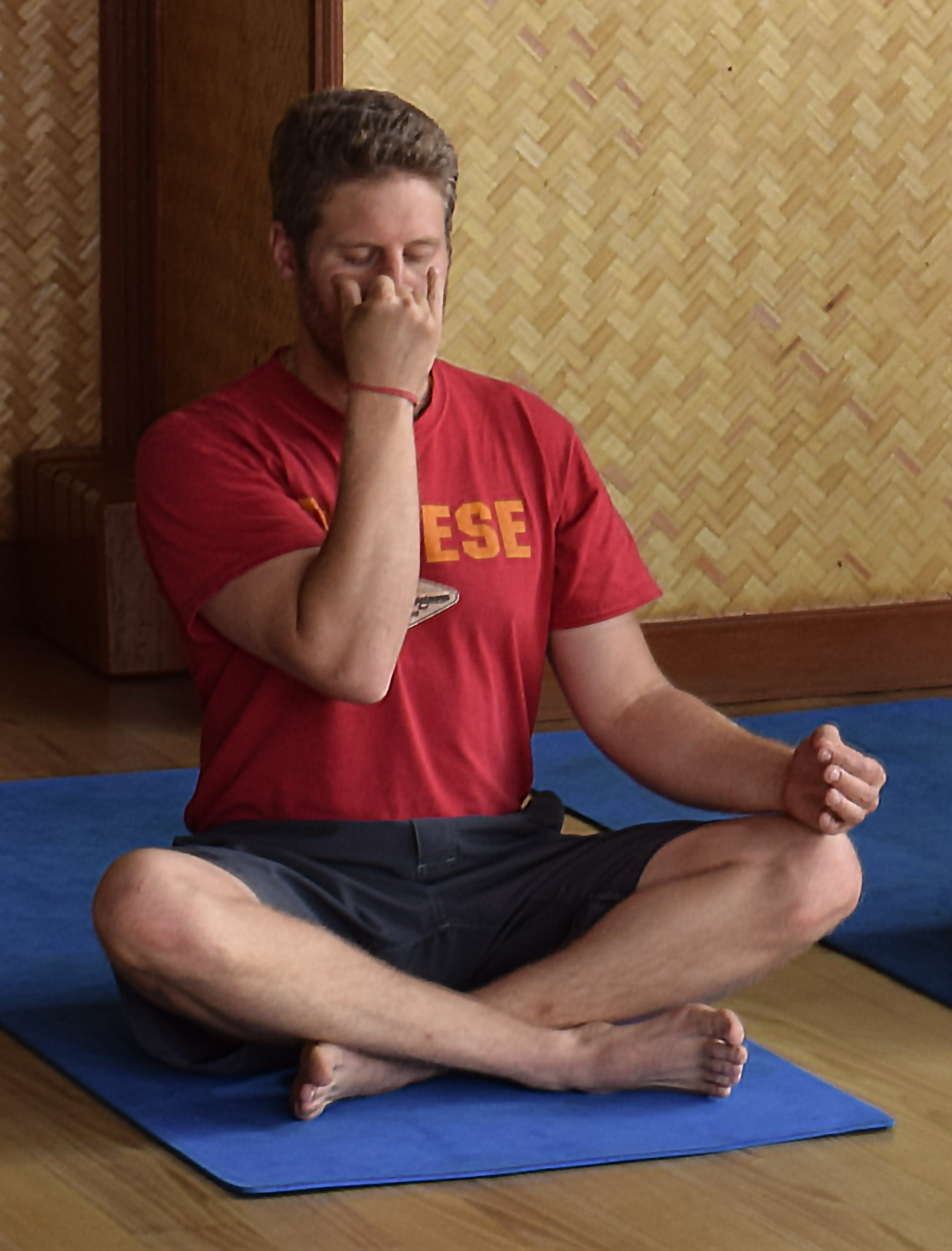Namaste! We are happy to welcome you into the world of Yoga. Here you will learn about an easy approach to applying yoga in daily life that will give you the power of self transformation.
“Health is Wealth, Peace of Mind is Happiness, Yoga Shows the Way.” – Swami Vishnudevananda
When our teacher Swami Vishnudevananda came to America in 1957 he created the five points of yoga as a simple way to explain the vast teaching of yoga to a society that had little knowledge of yoga or the broad culture of India. Even today these five points give straightforward, clear instructions to both new and advanced students, helping everyone progress on their journey towards health and happiness. Swami Vishnu’s five points are as follows:
- Proper Exercise – Asana
- Proper Breathing – Pranayama
- Proper Relaxation – Savasana
- Proper Diet – Lacto Vegetarian Diet
- Proper (Positive) Thinking and Meditation
Proper Exercise:
Proper Exercise is defined as Yoga Asana. Asana means steady pose, and is commonly referred to as a yogic posture. A typical “yoga class” is composed of a variety of these asanas, which is the most common form of yoga found throughout the world. But what makes Asana proper exercise as compared to working out in the gym or playing sports?
Asana practice is a balanced exercise that not only works the muscles but all the systems of the body and mind. When someone “works out”, the focus is primarily on the muscles and physical appearance. When you “work out”, the muscles become stronger but the muscle fibers become short and tight; this decreases our range of motion. Yoga asana focuses on simultaneously strengthening and lengthening the muscle fibers, increasing flexibility and range of motion. Each asana has its own inherent intelligence working not only on the muscles but on different systems of the body, e.g., digestive, circulatory, lymphatic, respiratory, nervous, etc., toning and cleansing the body at every level. (Please see asanas outline for details.) The asana practice has an inward focus on awareness of the body instead of focusing on the external appearance. Through asana practice, as the body and mind return to a state of balance, the practitioner’s appearance naturally becomes more radiant due to an inner state of health and happiness.
How you practice is an integral part to why asana is considered proper exercise. When we compete with ourselves or with others we create tension in the mind and body. This is counterproductive in the asana practice. The asana should always be practiced calmly and with control. There should never be pain or discomfort. When we overexert ourselves and start to strain or feel pain, the mind and body are not relaxed and it becomes more difficult to stretch the muscles. Anytime you feel discomfort or cannot breathe easily, it is a sure sign that you need to come out of the pose and find a position or variation that gives ease of breath and does not create more tension. Then only will you be at able to stretch the muscles and deepen your practice. Each day is different and so is the body. Therefore each day we must practice in a manner that is comfortable for that day, not comparing ourselves to our previous practices or setting goals that push us beyond our natural limits.
Yoga asana helps you become aware of the subtle nature of your body and the changes that are taking place in it every day. As you become more comfortable in the variety of yoga asanas and can hold them for longer periods of time, you will begin to see that these postures have a profound effect on calming the mind. As you begin to hold the body still the mind will naturally follow suit and become calm and quiet.
So, in summary, we practice asana to create greater awareness of the body, safely and gently bringing it back into a state of balance for overall health and peace of mind.
Proper Breathing:
Breath is life. From the moment we enter this world, we must breathe. But how efficiently do you breathe?
Yoga teaches us that our capacity to take deep complete breaths has a direct effect on how well the body and mind function. Through poor postural habits in modern life we lose the natural rhythm of breath and begin to breathe using only the upper 25-50% of the lungs.
The first part of proper breathing is retraining the body to use the diaphragm to take deep, abdominal breathes. The diaphragm is a muscle at the bottom of the the rib cage that, when contracted, expands and allows the lungs to inflate below the bottom of the ribs. Using the diaphragm also gives you the ability to completely exhale all the CO2 and other waste materials trapped in the lower parts of the lungs that prevent fresh clean air from being absorbed. Once this is mastered you can move on to learning the full yogic breath which effectively gives you the ability to use 100% of the lungs’ capacity to breathe. So for many people, simply relearning how to breathe will nearly double the volume of each breath and substantially increase the amount of oxygen brought into the bloodstream. An increase in oxygen in the body is directly related to having more energy and focus. (Click here for instructions on these techniques.)
But yoga says there’s still more… Through the practice of certain breathing techniques, called pranayama, you can cleanse the lungs, build the energy reserves in the body for future use and calm the mind. The two main techniques practiced are Kapala Bhati and Anuloma Viloma. Kaphala Bhati is a cleansing and energizing technique, designed to force stale air out of the lungs and rapidly bring a fresh supply of oxygen to the body. Anuloma Viloma, or Alternate Nostril Breathing, helps build up the energy reserve of the body and simultaneously balances the left and right hemispheres of the brain. (see for techniques)
When these techniques are applied correctly you begin to have more control over the breath, and when you control how you breathe you can begin to control and pacify the mind. When we can calm the mind, we are more easily able to focus on the task at hand and use much less energy for greater results.
Proper Relaxation:
Everyone must relax to recharge their body-mind system, but often our favorite forms of relaxation leave us short of feeling revitalized. Why is this?
In yoga we begin to understand that even when we relax the body, such as lying on the couch, if we don’t relax the mind we can expend significant amounts of energy through thought. Imagine curling up in bed and watching a horror movie that leaves you scared and worried at the end, thinking someone might be lurking in the shadows. Or you listen to emotional music that draws out memories of old relationships and causes you to feel depleted. Even going out with friends to “unwind” can be less than relaxing and may cause the next day to feel sluggish.
Proper relaxation is called Savasana and is defined as relaxation with minimal expense of either physical or mental energy. This relaxation takes place in three phases; physical, mental and spiritual. You begin by lying in Savasana. This pose is designed to release the muscles from holding tension, allowing the body to rest comfortably on the floor. This posture is the first step in physical relaxation. Next, we physically release any remaining tension from individual muscles by systematically tensing and releasing each part of the body. The third phase consists of auto suggestion, a mental scanning of the body, using the mind to command the body to completely and deeply relax.

Savasana, the Corpse Pose
Then we move into mental relaxation. When the mind is focused it becomes calm and peaceful. Think about why you enjoy your favorite hobby. When you are concentrating on anything, such as playing music or practicing a sport, everything else falls away and the mind becomes calm. We use this process of concentration to calm the mind by focusing on the breath coming in and out of the nose. The breath is a natural point of concentration that is with you everywhere you go.
As you lie in Savasana with the body relaxed and the mind calm and focused, eventually you will dissociate from the body and mind and come to rest in your higher self, sometimes called your true nature. This is when spiritual relaxation is reached, connecting you to an infinite source of energy that will completely recharge your body and mind. This spiritual relaxation cannot be forced, but happens naturally as we dissociate temporarily from the body and mind.
Savasana is a much more powerful practice than the power nap or a coffee break, naturally reinvigorating you without a sluggish re-awaking, jitters or a crash.
Savasana is practiced throughout the asana class to recharge between postures, and can be utilized as a stand alone practice anytime. See our Practice with Us section for Class, Pranayama and Savasana Recordings.
Proper Diet:

A simple, fresh vegetarian meal, served with love!
Food is almost as essential to life as breathing, but much like breathing we often overlook its significant influence on how the mind and body function. After all, you are what you eat! So when we eat foods that are processed, heavy, or stimulating, the body and mind react and become either lethargic or excited.
The yogic diet is a lacto-vegetarian diet, with a focus on fresh whole foods. Its simple premise is that the higher the purity of food you consume the lighter and happier your body and mind will remain. The yogi tries to eat simple fresh food that supports the body and mind to find a natural state of health.
Changing your diet should be a slow but steady process. Through this process not only do you change your unhealthy eating habits, but you get to positively build your will power. When you exert control over what you eat and decide not to listen to the subconscious mind’s craving, you will steadily regain your health with a wonderful new sense of self control. Continue to practice asana and pranayama while shifting your diet. These practices will support your ability to transition into new eating habits. If you would like to know more about the yogic diet please read this more detailed post. If you would like inspiration for cooking healthy vegetarian food, please see our Food for Liberation recipes section.
Proper (Positive) Thinking and Meditation:
Beginning with the gross physical body, we slowly work our way through breathing, relaxation, diet, and find ourselves ready to engage the most subtle aspect of the five points of yoga: the mind. The mind is not something that can be touched or seen and though we often associate the mind with the brain, the mind does not have a specific location in the physical body. However, all yoga practices are aimed at bringing control to the mind and making it our greatest ally in life, helping us to achieve all our goals and find peace.
The first step in working with the mind is to be aware of our thoughts and choose to culture positive thoughts. It is very easy to be negative. Negative thoughts take very little energy to produce but subsequently leave us feeling emotionally and physically drained. Positive thoughts take more energy to create, but generate more energy and keep us feeling uplifted and connected. So it is important to focus initially on positive thinking. Otherwise, how will you be able to sit still and meditate?
Here we present two aspects of positive thinking. One is working directly with the mind and thoughts. This can be done with positive affirmations, actively replacing negative thoughts with positive thoughts or by simply dissociating from the negative thoughts. Swami Sivananda’s famous daily affirmation is, “By the grace of God, I’m getting better and better, day by day in every way!” If we can rememberer to make positive affirmations when we wake up in the morning and throughout the day, we are reprogramming our mind to react positively when challenging situations present themselves.
When we have a negative thought about ourselves, people, places, situations, etc., we have the choice to change that thought into something positive. If you are dreading going to take a test, you can instead say, “I am prepared and will succeed!” Like this, slowly slowly we begin to change each thought, making the mind more positive.
We can also choose to ignore the mind. This is sometimes very difficult, but when we disassociate from a thought and no longer dwell on it, not giving it more energy, it will naturally go away. Wherever our mental energy goes so do our thoughts. These are just a few of the ways we can begin to adjust our thoughts proactively. The key is this must be an active process. The mind never stops, so likewise we must be vigilant. Patience is key. It may seem like a struggle at first, but over time this process will become easier and positive thought will become natural.
The second aspect of positive thinking is about having the correct perspective on life, or making right inquiry into “who am I” and the nature of the world. This is formally know as Vedanta. One of the main principles of Vedanta states that the nature of the world is change. Everything changes, including the mind, body, weather, animals, friends, buildings, jobs and so on. There is nothing we can see with our eyes or think of with the mind that does not change. So when we understand this principle of change, it becomes possible to avoid feeling emotional extremes and remain balanced in day to day life; instead of being surprised and reactionary when things around us change.
Then slowly slowly through the yoga practices we begin to remove the barriers of the mind and body and begin to identify with our higher self or spirit, known in yoga as the Atman. The Atman is the one principle in the universe that does not change; it is eternal and always at peace. Here the question of “Who am I” gets answered definitively. As we begin to identify with our higher self (Atman), negative thoughts vanish through right understanding of our true nature.

Find a quiet peaceful place to meditate.
Meditation naturally follows positive thinking, as it is very difficult to sit and turn your awareness inwards when the mind is negative. In our meditation practice there are three aspects to consider. First we begin to witness the mind, then we detach from the mind, and thirdly we concentrate the mind. Through the process of mediation we begin to see that the mind is not our identity. We watch the mind have all sorts of random disconnected thoughts. As we watch the mind more and more, we are able to then detach from the mind and are less likely to be swayed by its ambitions in daily life. Then we begin to concentrate the mind on the breath and then the mantra OM, or your personal mantra. As the mind wanders you gently bring the mind back to the breath and the point of concentration, slowly slowly training the mind to concentrate. Meditation, like sleep, is something you cannot force, but we prepare the mind for it through concentration. Eventually, through the extended practice of concentration the mind will slip into the state of meditation.
By daily practice of concentration and meditation you are able to calm the mind and direct it towards peace. Meditation is a method of cleansing your subconscious mind of useless thoughts and over time you naturally elevate your consciousness.
Thank you for reading about the five points of yoga. We hope as you explore our website you are able to begin integrating each of the five points into your life. If you have any questions, please don’t hesitate to Contact Us, we are happy to be of service. Hari Om Tat Sat, Om Shanti.
Wishing you Peace and Happiness.
– Your Rainbow Life Yogis





